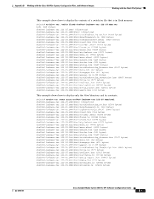HP Cisco Catalyst Blade Switch 3020 Cisco Catalyst Blade Switch 3020 for HP So - Page 647
Guidelines for Creating and Using Configuration Files
 |
View all HP Cisco Catalyst Blade Switch 3020 manuals
Add to My Manuals
Save this manual to your list of manuals |
Page 647 highlights
Appendix B Working with the Cisco IOS File System, Configuration Files, and Software Images Working with Configuration Files You can copy (download) configuration files from a TFTP, FTP, or RCP server to the running configuration or startup configuration of the switch. You might want to perform this for one of these reasons: • To restore a backed-up configuration file. • To use the configuration file for another switch. For example, you might add another switch to your network and want it to have a configuration similar to the original switch. By copying the file to the new switch, you can change the relevant parts rather than recreating the whole file. • To load the same configuration commands on all the switches in your network so that all the switches have similar configurations. You can copy (upload) configuration files from the switch to a file server by using TFTP, FTP, or RCP. You might perform this task to back up a current configuration file to a server before changing its contents so that you can later restore the original configuration file from the server. The protocol you use depends on which type of server you are using. The FTP and RCP transport mechanisms provide faster performance and more reliable delivery of data than TFTP. These improvements are possible because FTP and RCP are built on and use the TCP/IP stack, which is connection-oriented. These sections contain this configuration information: • Guidelines for Creating and Using Configuration Files, page B-9 • Configuration File Types and Location, page B-10 • Creating a Configuration File By Using a Text Editor, page B-10 • Copying Configuration Files By Using TFTP, page B-10 • Copying Configuration Files By Using FTP, page B-12 • Copying Configuration Files By Using RCP, page B-15 • Clearing Configuration Information, page B-18 Guidelines for Creating and Using Configuration Files Creating configuration files can aid in your switch configuration. Configuration files can contain some or all of the commands needed to configure one or more switches. For example, you might want to download the same configuration file to several switches that have the same hardware configuration. Use these guidelines when creating a configuration file: • We recommend that you connect through the console port for the initial configuration of the switch. If you are accessing the switch through a network connection instead of through a direct connection to the console port, keep in mind that some configuration changes (such as changing the switch IP address or disabling ports) can cause a loss of connectivity to the switch. • If no password has been set on the switch, we recommend that you set one by using the enable secret secret-password global configuration command. Note The copy {ftp: | rcp: | tftp:} system:running-config privileged EXEC command loads the configuration files on the switch as if you were entering the commands at the command line. The switch does not erase the existing running configuration before adding the commands. If a command in the copied configuration file replaces a command in the existing configuration file, the existing command is erased. For example, if the copied configuration file contains a different IP address in a particular command than the existing configuration, the IP address in the copied configuration is used. However, OL-8915-01 Cisco Catalyst Blade Switch 3020 for HP Software Configuration Guide B-9















